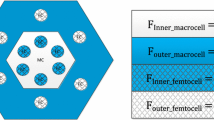Abstract
This paper investigates several new strategies for the allocation of radio resources (bandwidth and transmission power) using a non-orthogonal multiple access (NOMA) scheme with successive interference cancellation (SIC) in a cellular downlink system. In non-orthogonal access with SIC, the same subband is allocated to multiple users, which requires elaborate multiuser scheduling and subband assignment techniques, compared to orthogonal multiplexing. While taking into account various design issues, we propose and compare several optimum and suboptimum power allocation schemes. These are jointly implemented with multiple user scheduling strategies. Besides, a minimization of the total amount of used bandwidth is targeted. Also, to increase the total achieved system throughput, a hybrid orthogonal-non orthogonal scheme is introduced. This hybrid scheme enables a dynamic switching to orthogonal signaling whenever the non-orthogonal cohabitation in the power domain does not improve the achieved data rate per subband. Extensive simulation results show that the proposed strategies for resource allocation can improve both the spectral efficiency and the cell-edge user throughput, especially when compared to previous schemes employing either orthogonal signaling or NOMA with static inter-subband power allocation. They also prove to be robust in the context of crowded areas.













Similar content being viewed by others
References
NTT DOCOMO, Requirements, candidate solutions & technology roadmap for LTE Rel-12 onward. 3GPP RWS-120010, 2012.
Wunder, G. et al. (2014). 5GNOW: Non-orthogonal, asynchronous waveforms for future mobile applications. IEEE Communications Magazine 97–105.
Kishiyama, Y., Benjebbour, A., Ishii, H., & Nakamura, T. (2012). Evolution concept and candidate technologies for future steps of LTE-A, IEEE International Conference on Communication Systems.
3GPP TS36.300, Evolved Universal Terrestrial Radio Access (E-UTRA) and Evolved Universal Terrestrial Radio Access Network (E-UTRAN); Overall description.
3GPP TR36.913 (V8.0.0), 3GPP; TSG RAN; Requirements for further advancements for E-UTRA (LTE-Advanced), 2008.
3GPP TR36.814 (V9.0.0), Further advancements for E-UTRA physical layer aspects, 2010.
Farah, J., & Marx, F. (2007). Combining strategies for the optimization of resource allocation in a wireless multiuser OFDM system. AEU International Journal of Electronics and Communications, 61(10), 665–677.
Han, S., Kim, H., Han, Y., Cioffi, J. M., & Leung, V. C. M. (2010). A distributed power allocation scheme for sum-rate maximization on cognitive GMACs. In The international symposium on personal, indoor and mobile radio communications, pp. 1854–1858.
Mahmoud, H., Yucek, T., & Arslan, H. (2009). OFDM for cognitive radio: Merits and challenges. IEEE Wireless Communications, 16(2), 6–15.
Rhee, W., & Cioffi, J. (2000). Increase in capacity of multiuser OFDM system using dynamic subchannel allocation. In IEEE Vehicular technology conference, pp. 1085–9
Kim, K., Kim, H., Han, Y., & Kim, S.L. (2004). Iterative and greedy resource allocation in an uplink OFDMA system. In The international symposium on personal, indoor and mobile radio communications, pp. 2377–81.
Caire, G., & Shamai, S. (2003). On the achievable throughput of a multi-antenna Gaussian broadcast channel. IEEE Transactions on Information Theory, 49(7), 1692–1706.
Takeda, T., & Higuchi, K. (2011). Enhanced user fairness using non-orthogonal access with SIC in cellular uplink. In IEEE vehicular technology conference.
Higuchi, K., & Kishiyama, Y. (2012). Non-orthogonal access with successive interference cancellation for future radio access. In IEEE Vehicular Technology Society, Asia Pacific Wireless communications symposium.
Higuchi, K., & Kishiyama, Y. (2013). Non-orthogonal access with random beamforming and intra-beam SIC for cellular MIMO downlink. In IEEE Vehicular technology conference.
Otao, N., Kishiyama, Y., & Higuchi, K. (2012). Performance of non-orthogonal access with SIC in cellular downlink using proportional fair-based resource allocation. In International symposium on wireless communication systems, pp. 476–480.
Saito, Y., Kishiyama, Y., Benjebbour, A., Nakamura, T., Li, A., & Higuchi, K. (2013). Non-orthogonal multiple access (NOMA) for future radio access. In IEEE Vehicular technology conference.
Umehara, J., Kishiyama, Y., & Higuchi, K. (2012). Enhancing user fairness in non-orthogonal access with successive interference cancellation for cellular downlink. In International conference on communication systems.
Sharp corporation, Evolving RAN towards Rel-12 and beyond, RWS-120039, 3GPP Workshop on Release 12 Onward Ljubljana, Slovenia (2012).
Benjebbour, A., Saito, Y., Kishiyama, Y., Li, A., Harada, A, & Nakamura, T. (2013). Concept and practical considerations of non-orthogonal multiple access (NOMA) for future radio access. International symposium on intelligent signal processing and communication systems (ISPACS).
Ding, Z., Yang, Z., Fan, P., & Poor, H. (2014). On the performance of non-orthogonal multiple access in 5G systems with randomly deployed users. IEEE Signal Processing Letters, 21(12), 1501–1505.
Benjebbour, A., Li, A., Saito, Y., Kishiyama, Y., Harada, A., & Nakamura, T. (2013). System-level performance of downlink NOMA for future LTE enhancements. In IEEE Globecom.
Schaepperle, J. (2010). Throughput of a wireless cell using superposition based multiple-access with optimized scheduling. In The international symposium on personal, indoor and mobile radio communications, pp. 212–21.
Kim, B., Lim, S., Kim, H., Suh, S., Kwun, J., Choi, S., Lee, C., Lee, S., & Hong, D. (2013). Non-orthogonal Multiple Access in a Downlink Multiuser Beamforming System, MILCOM.
Tse, D., & Viswanath, P. (2005). Fundamentals of wireless communication. Cambridge: Cambridge University Press.
Tomida, S., & Higuchi, K. (2011). Non-orthogonal Access with SIC in Cellular Downlink for User Fairness Enhancement. In International symposium on intelligent signal processing and communication systems (ISPACS), pp. 1–6.
Saito, Y., Benjebbour, A., Kishiyama, Y., & Nakamura, T. (2013). System-level performance evaluation of downlink non-orthogonal multiple access (NOMA). In The international symposium on personal, indoor and mobile radio communications, pp. 611–615.
Boyd, S., & Vandenberghe, L. (2003). Convex optimization. Cambridge: Cambridge University Press.
Haykin, S. (2001). Communication systems (4th ed.). Colorado: Wiley.
Dennis, J. E, Jr, & Schnabel, R. B. (1983). Numerical methods for unconstrained optimization and nonlinear equations. Upper Saddle River: Prentice-Hall.
Powell, M. J. D. (1984). On the global convergence of trust region algorithms for unconstrained minimization. Mathematical Programming, 29(3), 297–303.
Author information
Authors and Affiliations
Corresponding author
Rights and permissions
About this article
Cite this article
Hojeij, MR., Farah, J., Nour, C.A. et al. New Optimal and Suboptimal Resource Allocation Techniques for Downlink Non-orthogonal Multiple Access. Wireless Pers Commun 87, 837–867 (2016). https://doi.org/10.1007/s11277-015-2629-2
Published:
Issue Date:
DOI: https://doi.org/10.1007/s11277-015-2629-2




